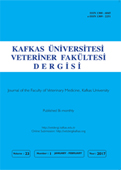
This journal is licensed under a Creative Commons Attribution-NonCommercial 4.0 International License
Kafkas Üniversitesi Veteriner Fakültesi Dergisi
2018 , Vol 24 , Issue 1
Isolation and Antibiotic Susceptibilities of Beta Hemolytic Streptococcus Species from Various Body Site Infections with Cytologic Evidences in Thoroughbred and Arabian Racehorses in Turkey
1Jockey Club of Turkey İstanbul Veliefendi Racetrack Horse Hospital, TR-34144 Bakırköy, İstanbul - TURKEY
DOI :
10.9775/kvfd.2017.18370
Streptococcal microorganisms mostly beta hemolytic streptococci are the most important and widespread bacterial agents causing infectious
diseases in horses and they often follow a difficult course. The goals of the present study are to determine; i) together with cytologic findings, the
system distributions of the beta hemolytic streptococci as a primary pathogen, ii) the susceptibility patterns to the most commonly used antibiotics in
thoroughbred and Arabian racing horses iii) the presence of multiple antibiotics resistance of beta hemolytic streptococci encountered in horses. Beta
hemolytic streptococci isolated and cytologically neutrophilic inflammation confirmed samples which were submitted to Jockey Club of Turkey horse
hospital laboratory between April 2014 – April 2017 were included into the study. The study was conducted on 128 samples including tracheal wash
(71.9%), endometrial swabs (21.9%), abscess material (5.4%) and urine sample (0.8%). According to the isolation results, S. equi subsp. zooepidemicus (S.
zooepidemicus), S. dysgalactiae subsp. equisimilis (S. equisimilis) and S. equi subsp. equi (S. equi) were isolated from whole samples as 80.4%, 14.1% and
5.5% respectively. Antibiotics susceptibility results demonstrated that amoxicillin/clavulanic acid (100%), amoxicillin (100%), ampicillin (100%), penicillin
(100%), imipenem (100%), ampicillin/sulbactam (100%), rifampicin (97.6%), ceftiofur (100%) and ceftazidime (87.5%) were found to be effective, while
enrofloxacin (14.8%), amikacin (0.8%), gentamicin (4.7%), kanamycin (0%), neomycin (0%), streptomycin (0%), oxytetracycline (7.0%) and trimethoprim/
sulfamethoxazole (27.3%) were found to be mostly uneffective. The multiple antibiotics resistance rate was found to be 1.6% amongst beta hemolytic
streptococci isolates in horses. These results of the present study confirmed the results of many similiar previous studies that S. zooepidemicus was the
most frequently isolated beta hemolytic Streptococcus species followed by S. equisimilis and S. equi. In suspecious infections where a beta hemolytic
streptococcal infection is suspected penicillin should be considered as the first line antimicrobial for horses when results of the samples submitted for
bacterial culture and susceptibility test results are pending.
Keywords :
Antibiotic susceptibility, Beta hemolytic streptococci, Cytology, Horse, Lancefield group C Streptococcus spp










